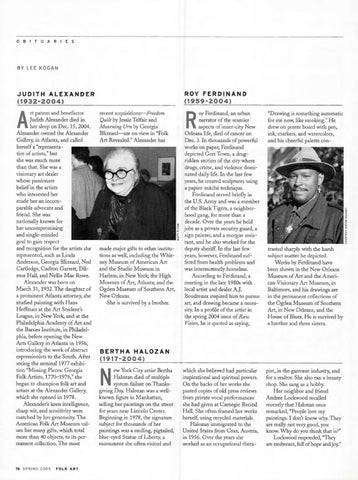OBITUARIES
BY LEE KOGAN
ROY FERDINAND (1959-2004)
JUDITH ALEXANDER (1932-2004) rt patron and benefactor Judith Alexander died in her sleep on Dec. 15,2004. Alexander owned the Alexander Gallery,in Atlanta, and called herself a "representative of artists," but she was much more than that. She was a visionary art dealer whose passionate beliefin the artists who interested her made her an incomparable advocate and friend. She was nationally known for her uncompromising and single-minded goal to gain respect and recognition for the artists she represented, such as Linda Anderson, Georgia Blizzard, Ned Cartledge, Carlton Garrett, Dilmus Hall, and Nellie Mae Rowe. Alexander was born on March 31, 1932.The daughter of a prominent Atlanta attorney,she studied painting with Hans Hoffman at the Art Student's League,in New York,and at the Philadelphia Academy of Art and the Barnes Institute,in Philadelphia, before opening the New Arts Gallery in Atlanta in 1956, introducing the work ofabstract expressionists to the South. After seeing the seminal 1977 exhibition "Missing Pieces: Georgia Folk Artists, 1770-1976,"she began to champion folk art and artists at the Alexander Gallery, which she opened in 1978. Alexander's keen intelligence, sharp wit, and sensitivity were matched by her generosity The American Folk Art Museum values her many gifts, which total more than 40 objects, to its permanent collection.The most
A
76 SPRING 2005
FOLK ART
recent acquisitions—Freedom Quilt by Jessie Telfair and Mourning Urn by Georgia Blizzard—are on view in "Folk Art Revealed." Alexander has
made major gifts to other institutions as well,including the Whitney Museum of American Art and the Studio Museum in Harlem,in New York; the High Museum of Art,Atlanta; and the Ogden Museum of Southern Art, New Orleans. She is survived by a brother.
oy Ferdinand, an urban narrator ofthe seamier aspects ofinner-city New Orleans life, died of cancer on Dec. 3.In thousands of powerful works on paper, Ferdinand depicted Gert Town,a drugridden section of the city where drugs,crime,and violence dominated daily life. In the last few years, he created sculptures using a papier-mâché technique. Ferdinand served briefly in the U.S. Army and was a member ofthe Black Tigers, a neighborhood gang,for more than a decade. Over the years he held jobs as a private security guard, a sign painter, and a morgue assistant, and he also worked for the deputy sheriff. In the last few years, however, Ferdinand suffered from health problems and was intermittently homeless. According to Ferdinand,a meeting in the late 1980s with local artist and dealer A.J. Boudreaux inspired him to pursue art, and drawing became a necessity. In a profile ofthe artist in the spring 2004 issue ofRaw Vision, he is quoted as saying,
"Drawing is something automatic for me now,like smoking." He drew on poster board with pen, ink, markers, and watercolors, and his cheerful palette con-
which she believed had particular inspirational and spiritual powers. On the backs of her works she pasted copies ofold press reviews from private vocal performances she had given at Carnegie Recital Hall. She often framed her works herself; using recycled materials. Halozan immigrated to the United States from Graz,Austria, in 1956. Over the years she worked as an occupational thera-
pist, in the garment industry and for a realtor. She also ran a beauty shop. She sang as a hobby. Her neighbor and friend Andree Lockwood recalled recently that Halozan once remarked,"People love my paintings.I don't know why.They are really not very good, you know.Why do you think that is?" Lockwood responded,"They are exuberant,full ofhope and joy"
R
trasted sharply with the harsh subject matter he depicted. Works by Ferdinand have been shown in the New Orleans Museum of Art and the American Visionary Art Museum,in Baltimore, and his drawings are in the permanent collections of the Ogden Museum of Southern Art,in New Orleans,and the House of Blues. He is survived by a brother and three sisters.
BERTHA HALOZAN (1917-2004) ew York City artist Bertha Halozan died of multiple system failure on Thanksgiving Day. Halozan was a wellknown figure in Manhattan, selling her paintings on the street for years near Lincoln Center. Beginning in 1978,the signature subject for thousands of her paintings was a smiling, pigtailed, blue-eyed Statue ofLiberty a monument she often visited and
N
